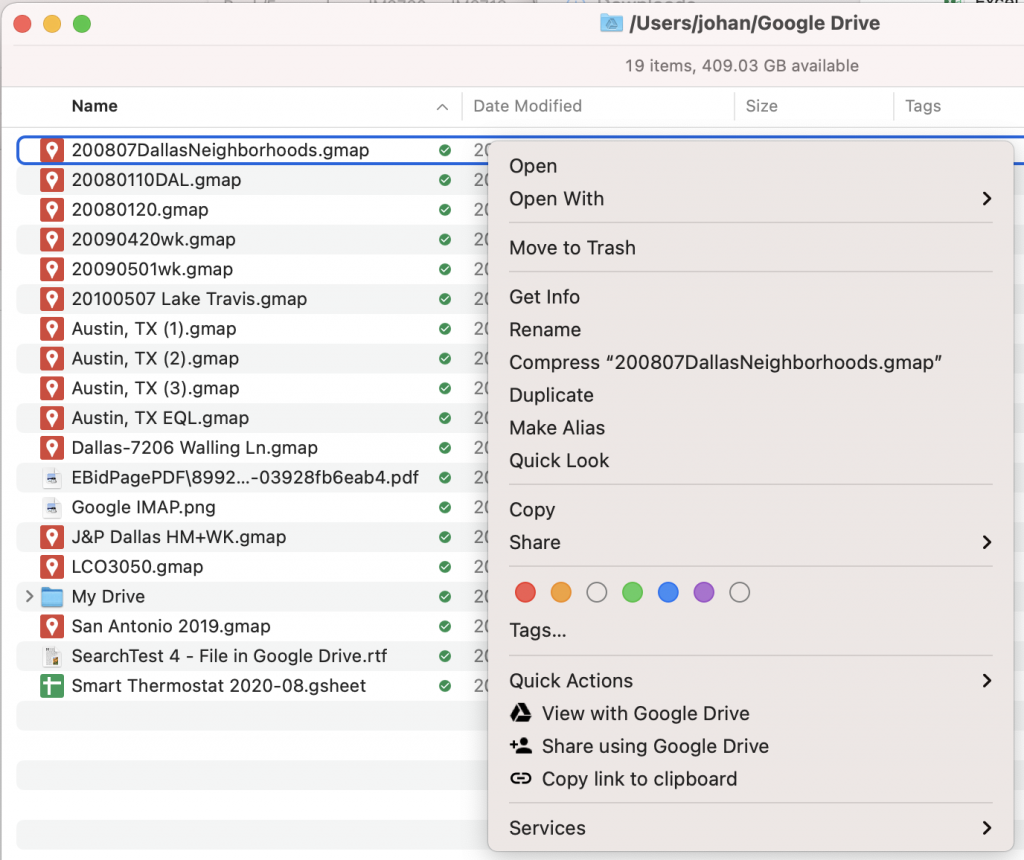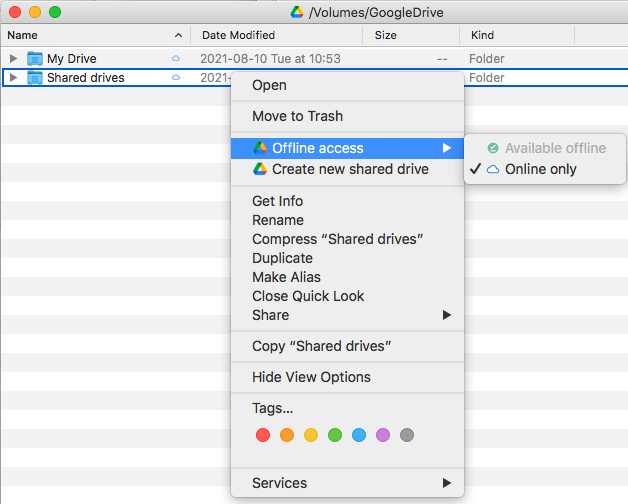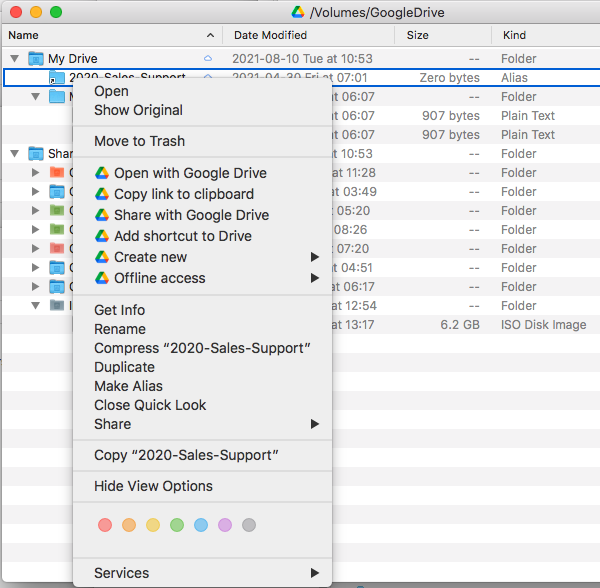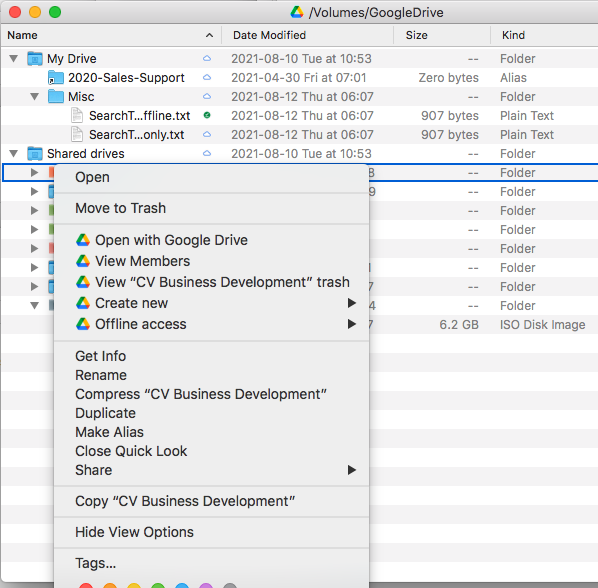Google Drive – Dropbox-alternative, some use
Contents
- 1 General
- 2 A Bit of Terminology
- 3 A Bit Side-by-Side Comparison
- 4 Administration
- 5 Apple iOS Use
- 6 Apple macOS Use
- 7 Command Line
- 8 Recovery, Deleted Files, Versions
- 9 Status, Statuses, of File System Items
- 10 Using a Backup and Sync installation
- 11 Using a Google Drive for desktop installation
- 12
- 13 ‘Cache’
- 14 More research
- 15 Remove Google Drive
General
- Info:
- Access:
- drive.google.com – suitable general link to use
- My Drive – drive.google.com/drive/my-drive
- Shared Drives – drive.google.com/drive/shared-drives
A Bit of Terminology
- ‘Google Drive’ – service, online / cloud-based storage
- more below
- ‘Backup and Sync’ – application (software)
- ‘Backup and Sync from Google.app’ – application on macOS (/Applications/)
- Deploy Backup and Sync – support.google.com/a/answer/2490101
- Compare Backup and Sync & Google Drive for desktop – support.google.com/drive/answer/7638428?hl=en
- ‘Drive File Stream’ – name of earlier software that in 2021 changes name to ‘Google Drive for desktop’
- Drive File Stream’s name is changing to Google Drive for desktop. Learn more about the change.
- ‘Google Drive for desktop’ – application (software)
- ‘Google Drive.app’ – application on macOS (/Applications/)
- Use Google Drive for desktop
support.google.com/googleone/answer/10838124?visit_id=637647914723634719-1589091194&rd=1
- “What it means to mirror or stream your files”
- mirror copies of files from local desktop to cloud, local disk space IS fully occupied
- stream keeps references on local filesystem but actual content is only online in cloud, until one of:
- opens and works with file – temporary copy is downloaded locally
- mark file “Offline Access” > “Available offline”
- “Switch from mirroring to streaming”
- CANNOT use BOTH
- And switching from mirroring to streaming will:
- change location of files
- create a volume that is mount,
- where files with NOW reside
- create a volume that is mount,
- leave old mirroring copy that really should be removed, to avoid confusion and risk of working with old copies (that are not in mounted volume)
- change location of files
- ‘Team Drives’ – old name
- (2019) “The “Team Drives” feature of Google Drive will be renamed to “shared drives.” This will impact:”…. googleblog.com
- ‘Drive File Stream’ is now ‘Drive for desktop’.
A Bit Side-by-Side Comparison
| Local FS | Cache use | du, Cmd+I | |
| Backup and Sync | 100% | No | Local FS |
| Google Drive | Varies, below | Varies, below | Remote FS |
| * My Drive | (-“-) | ||
| 1. Mirror files | 100% | Yes | (-“-) |
| 2. Stream files | No normally | Yes (Offline files) | (-“-) |
| * Shared drives | No normally | Yes (Offline files) | (-“-) |
- Choose a sync solution – support.google.com/a/answer/7491633?hl=en
- Compare Backup and Sync & Google Drive for desktop – support.google.com/drive/answer/7638428?hl=en
| Backup and Sync | Google Drive for desktop | |
|---|---|---|
| Use files in My Drive | Yes | Yes |
| Use files in shared drives | No | Yes |
| Sync only selected folders in My Drive* | Yes | Yes |
| Sync only individual files in My Drive* | No | Yes |
| Use native apps, like Microsoft Office & Photoshop | Yes | Yes |
| See who’s editing with real-time presence in Microsoft Office | No | Yes |
| Integrates with Microsoft Outlook, Meet scheduling | No | Yes |
| Sync other folders, like Documents or Desktop | Yes | No |
| Use with your personal Google Account, ..@gmail.com | Yes | Yes |
| Use with your work or school Google Account | Yes | Yes |
| Upload photos and videos to Google Photos | Yes | No |
*With Google Drive for desktop, you can make selected files or folders ‘Available offline’ to sync them to your computer rather than an online stream.
Administration
- Deploy Google Drive for desktop – support.google.com/a/answer/7491144?hl=en
- Drive FAQ for admins – support.google.com/a/answer/2490100
Apple iOS Use
Another Google app to download… “Google Drive’ (download, in app store; simply ‘Drive’ as icon once installed; along with the already installed ‘Google Earth’, ‘Google Maps’, ‘Street View’, ‘Chrome’, ‘Google’, ‘Google Home’, ‘Google Photos’, ‘Gmail’, ‘Assistant’, and ‘Google Wi-Fi’… some cleaning is due….!)
google.com/search?q=google+drive+on+iphone
Apple macOS Use
- google.com/search?q=folder+icon+google+drive
- The Dock and Google Drive alias ain’t playing nice…….
Command Line
Need to do more research… What – if any – command line interface tools that exists for working, checking status, … with items on Google Drive.
Recovery, Deleted Files, Versions
- google.com/search?q=google+drive+version+history
- Check or revert to earlier file versions – support.google.com/a/users/answer/9308971?hl=en
Status, Statuses, of File System Items
Need to do more research…
Using a Backup and Sync installation
Mirroring content from local file system into cloud.
Finder Right-Click Contextual Pop-up menu:
- More limited Google Drive – options
- No option for controlling Offline access, including no ‘Online only’
Using a Google Drive for desktop installation
A mounted volume, in comparison to mirroring of folders on local FS, drivefs:
mbp17:~ $ mount /dev/disk1s1 on / (apfs, local, journaled) devfs on /dev (devfs, local, nobrowse) /dev/disk1s4 on /private/var/vm (apfs, local, noexec, journaled, noatime, nobrowse) /dev/disk1s5 on /Volumes/macOS 10.15 Catalina (apfs, local, journaled) map -hosts on /net (autofs, nosuid, automounted, nobrowse) map auto_home on /home (autofs, automounted, nobrowse) drivefs on /Volumes/GoogleDrive (dfsfuse_DFS, local, nodev, nosuid, synchronous, mounted by j) mbp17:~ $
Finder Right-Click Contextual Pop-up menu:
- Way more Google Drive – options, some depending on type of drive (My / Shared) – more below
- Option for controlling Offline access, including ‘Online only’
‘Cache’
‘Google Drive’ temporary storage, cache, is ‘a’ location to keep an eye on if/when start running out of local disk space!
Using ‘a’ [location] as we’ve realized it could be one of two different cache locations – ../Drive/ or ../DriveFS’ (Own Research below) – but independently of which, ‘a’ folder that can easily grow to gigabytes and way more depending on your use patterns of ‘Google Drive’, files used/kept open and ‘Available offline’-state.
Own Research
- On macOS:
- “$HOME/Library/Application Support/Google/Drive”
- IF using Backup and Sync, mirroring, for temporary files
- CAN grow also quite big, as may be used to synchronize a connected iPhone to Google Drive cloud
- Realized when in August 2021 see this folder is actually already some 200 GB…
- 216.35 GB when first realize, and then grows in front of my eyes, as got an iPhone connected to computer in question,
- 230.03 GB after just a four minutes, and continue to grow
- Realized when in August 2021 see this folder is actually already some 200 GB…
- “$HOME/Library/Application Support/Google/DriveFS”
- IF using Google Drive for desktop, mounted volume
- “$HOME/Library/Application Support/Google/Drive”
Official Info, on Cache Location
From support.google.com/a/answer/2490100#zippy=%2Cwhere-is-the-drive-for-desktop-cache
Where is the Drive for desktop cache?
If you need to blacklist the Drive for desktop cache from virus or backup software, exclude this directory:
-
- Windows:
%LOCALAPPDATA%\Google\DriveFS - Mac:
~/Library/Application Support/Google/DriveFS
- Windows:
Warning – Actual Functionality
‘WARNING’ / NOTE on how actually works:
If making a copy of a file stored in a Google Drive folder using streaming config and ‘Offline access > Online only’ into a folder on your local drive, the following happens:
- First, to keep in mind/understand: what is occupying space on local disk is only a small reference, think area of maybe a few hundred bytes (not researched in detail)
- Keep in mind files are stored on an own mounted volume, no any mirrored folder
- (Disk use/du thus refer to size occupied on the mounted volume, NOT your local internal disk)
- So when copying happens (let’s use copying a 6 GB archive as example):
- First a copy of file is downloaded onto local FS, into ‘Cache’ above.
- Local FS/Cache grows by 6 GB, local available disk space shrinks by 6 GB.
- And time to download / ‘make copy’ can take significant time, unless have fast broadband service
- Then/in parallel, the copy is also made: another 6 GB is eventually allocated on local FS
- Local FS grows by another 6 GB, 12 GB in total
- First a copy of file is downloaded onto local FS, into ‘Cache’ above.
- I.e. available, free, space on local disk has eventually shrunk by 12 GB.
Clearing Cache
Actually not yet found a clearly described process how to clean up content in cache….
- How to Clear Cache of Google Drive File Stream? – support.google.com/a/thread/7095609/how-to-clear-cache-of-google-drive-file-stream?hl=en a Q&A where A refer to article below but not yet found good instruction (not looked that close yet)
- Deploy Google Drive for desktop – support.google.com/a/answer/7491144?hl=en
- Your disk space is running low – support.google.com/a/answer/10496072?hl=en&ref_topic=7455083 – talks about importance to actually HAVE free local disk space.
One Answer in How to Clear … discussion above sounds like most promising:
‘ I just marked everything that I wanted to be “Online Only,” signed out of Drive Filestream, quit the Drive FS application, then restarted the application and signed in. It freed up about 150GB. ‘ (a Bob T, 4/13/20)
More detailed discussion around clearing cache – Google Drive clear cache – remarkablemark.org/blog/2020/10/03/google-drive-clear-cache/
More research
- Upload files and folders to Google Drive – support.google.com/drive/answer/2424368
- google.com/search?q=google+drive+online+only+space+on+local+disk
- quora.com/Why-does-Google-drive-still-using-my-hard-drive-space-on-my-laptop
Remove Google Drive
- google.com/search?q=uninstall+google+drive+mac
- cleanerone.trendmicro.com/blog/uninstall-google-drive-mac/
- Followed main thoughts along steps on this site for a MBP in Dec 2022.
- This after laptop was really struggling, working hard, and Google Drive *was* at top in Activity Monitor, and really wasn’t using it – had it installed more for tests and evaluations than anything else.
- Disconnected Drive via Google Drive app preferences
- Removed app manually
- Had to kill running Google Drive processes via Activity Monitor, some even with ‘Force Quit’ as refused to stop…
- Removed starting-up in User account preferences manually
- Removed files in ~/Library/Application Supple/Google/DriveFS manually (whole folder)
- Never restarted Mac
- Altogether laptop become actually quite remarkable more responsible……
- This after laptop was really struggling, working hard, and Google Drive *was* at top in Activity Monitor, and really wasn’t using it – had it installed more for tests and evaluations than anything else.
- Followed main thoughts along steps on this site for a MBP in Dec 2022.



